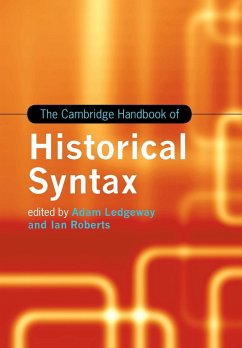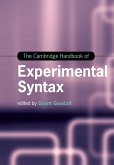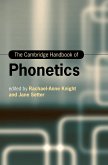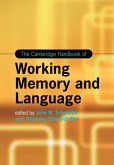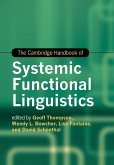The Cambridge Handbook of Historical Syntax
Herausgeber: Ledgeway, Adam; Roberts, Ian
The Cambridge Handbook of Historical Syntax
Herausgeber: Ledgeway, Adam; Roberts, Ian
- Broschiertes Buch
- Merkliste
- Auf die Merkliste
- Bewerten Bewerten
- Teilen
- Produkt teilen
- Produkterinnerung
- Produkterinnerung
With individual chapters embracing different theoretical perspectives, from the purely descriptive to formal analyses of novel data, this Handbook provides readers with an exhaustive treatment of historical syntax, and is an invaluable resource for postgraduates and researchers in the field.
Andere Kunden interessierten sich auch für
![The Cambridge Handbook of Experimental Syntax The Cambridge Handbook of Experimental Syntax]() The Cambridge Handbook of Experimental Syntax71,99 €
The Cambridge Handbook of Experimental Syntax71,99 €![The Cambridge Handbook of Japanese Linguistics The Cambridge Handbook of Japanese Linguistics]() The Cambridge Handbook of Japanese Linguistics56,99 €
The Cambridge Handbook of Japanese Linguistics56,99 €![The Cambridge Handbook of Phonetics The Cambridge Handbook of Phonetics]() The Cambridge Handbook of Phonetics152,99 €
The Cambridge Handbook of Phonetics152,99 €![The Cambridge Handbook of Working Memory and Language The Cambridge Handbook of Working Memory and Language]() The Cambridge Handbook of Working Memory and Language48,99 €
The Cambridge Handbook of Working Memory and Language48,99 €![The Cambridge Handbook of Discourse Studies The Cambridge Handbook of Discourse Studies]() The Cambridge Handbook of Discourse Studies46,99 €
The Cambridge Handbook of Discourse Studies46,99 €![The Cambridge Handbook of Systemic Functional Linguistics The Cambridge Handbook of Systemic Functional Linguistics]() The Cambridge Handbook of Systemic Functional Linguistics52,99 €
The Cambridge Handbook of Systemic Functional Linguistics52,99 €![The Cambridge Handbook of Translation The Cambridge Handbook of Translation]() The Cambridge Handbook of Translation48,99 €
The Cambridge Handbook of Translation48,99 €-
-
-
With individual chapters embracing different theoretical perspectives, from the purely descriptive to formal analyses of novel data, this Handbook provides readers with an exhaustive treatment of historical syntax, and is an invaluable resource for postgraduates and researchers in the field.
Hinweis: Dieser Artikel kann nur an eine deutsche Lieferadresse ausgeliefert werden.
Hinweis: Dieser Artikel kann nur an eine deutsche Lieferadresse ausgeliefert werden.
Produktdetails
- Produktdetails
- Cambridge Handbooks in Language and Linguistics
- Verlag: Cambridge University Press
- Seitenzahl: 748
- Erscheinungstermin: 15. Dezember 2022
- Englisch
- Abmessung: 244mm x 170mm x 40mm
- Gewicht: 1248g
- ISBN-13: 9781107627895
- ISBN-10: 1107627893
- Artikelnr.: 66223881
- Herstellerkennzeichnung
- Libri GmbH
- Europaallee 1
- 36244 Bad Hersfeld
- gpsr@libri.de
- Cambridge Handbooks in Language and Linguistics
- Verlag: Cambridge University Press
- Seitenzahl: 748
- Erscheinungstermin: 15. Dezember 2022
- Englisch
- Abmessung: 244mm x 170mm x 40mm
- Gewicht: 1248g
- ISBN-13: 9781107627895
- ISBN-10: 1107627893
- Artikelnr.: 66223881
- Herstellerkennzeichnung
- Libri GmbH
- Europaallee 1
- 36244 Bad Hersfeld
- gpsr@libri.de
Introduction Adam Ledgeway and Ian Roberts
Part I. Types and Mechanisms of Syntactic Change: 1. Grammaticalization Heiko Narrog and Bernd Heine
2. Degrammaticalization David Willis
3. Exaptation John Haiman
4. Reanalysis Nerea Madariaga
5. Analogy and extension Alice C. Harris
6. Restructuring David W. Lightfoot
7. Parameter setting Theresa Biberauer and Ian Roberts
8. Contact and borrowing Tania Kuteva
Part II. Methods and Tools: 9. The comparative method and comparative reconstruction James Clackson
10. Internal reconstruction Gisella Ferraresi and Maria Goldbach
11. Corpora and quantitative methods Susan Pintzuk, Ann Taylor and Anthony Warner
12. Phylogenetic reconstruction in syntax: the parametric comparison method Giuseppe Longobardi and Cristina Guardiano
Part III. Principles and Constraints: 13. Universal grammar Anders Holmberg
14. Abduction Henning Andersen
15. Transparency David W. Lightfoot
16. Uniformitarianism Ian Roberts
17. Markedness, naturalness and complexity Anna Roussou
18. Acquisition and learnability David W. Lightfoot
Part IV. Major Issues and Themes: 19. The actuation problem George Walkden
20. Inertia Ian Roberts
21. Gradience and gradualness vs abruptness Marit Westergaard
22. Cyclicity Elly van Gelderen
Part V. Explanations: 23. Endogenous and exogenous theories of syntactic change David Willis
24. Imperfect transmission and discontinuity David W. Lightfoot
25. Social conditioning Suzanne Romaine
26. Non-syntactic sources and triggers of syntactic change Laurel J. Brinton and Elizabeth Closs Traugott
Part VI. Models and Approaches: 27. Principles and parameters Adam Ledgeway and Ian Roberts
28. Biolinguistics Cedric Boeckx, Pedro Tiago Martins and Evelina Leivada
29. Lexical-functional grammar Kersti Börjars and Nigel Vincent
30. Typological approaches Sonia Cristofaro and Paolo Ramat
31. Functional approaches Marianne Mithun.
Part I. Types and Mechanisms of Syntactic Change: 1. Grammaticalization Heiko Narrog and Bernd Heine
2. Degrammaticalization David Willis
3. Exaptation John Haiman
4. Reanalysis Nerea Madariaga
5. Analogy and extension Alice C. Harris
6. Restructuring David W. Lightfoot
7. Parameter setting Theresa Biberauer and Ian Roberts
8. Contact and borrowing Tania Kuteva
Part II. Methods and Tools: 9. The comparative method and comparative reconstruction James Clackson
10. Internal reconstruction Gisella Ferraresi and Maria Goldbach
11. Corpora and quantitative methods Susan Pintzuk, Ann Taylor and Anthony Warner
12. Phylogenetic reconstruction in syntax: the parametric comparison method Giuseppe Longobardi and Cristina Guardiano
Part III. Principles and Constraints: 13. Universal grammar Anders Holmberg
14. Abduction Henning Andersen
15. Transparency David W. Lightfoot
16. Uniformitarianism Ian Roberts
17. Markedness, naturalness and complexity Anna Roussou
18. Acquisition and learnability David W. Lightfoot
Part IV. Major Issues and Themes: 19. The actuation problem George Walkden
20. Inertia Ian Roberts
21. Gradience and gradualness vs abruptness Marit Westergaard
22. Cyclicity Elly van Gelderen
Part V. Explanations: 23. Endogenous and exogenous theories of syntactic change David Willis
24. Imperfect transmission and discontinuity David W. Lightfoot
25. Social conditioning Suzanne Romaine
26. Non-syntactic sources and triggers of syntactic change Laurel J. Brinton and Elizabeth Closs Traugott
Part VI. Models and Approaches: 27. Principles and parameters Adam Ledgeway and Ian Roberts
28. Biolinguistics Cedric Boeckx, Pedro Tiago Martins and Evelina Leivada
29. Lexical-functional grammar Kersti Börjars and Nigel Vincent
30. Typological approaches Sonia Cristofaro and Paolo Ramat
31. Functional approaches Marianne Mithun.
Introduction Adam Ledgeway and Ian Roberts
Part I. Types and Mechanisms of Syntactic Change: 1. Grammaticalization Heiko Narrog and Bernd Heine
2. Degrammaticalization David Willis
3. Exaptation John Haiman
4. Reanalysis Nerea Madariaga
5. Analogy and extension Alice C. Harris
6. Restructuring David W. Lightfoot
7. Parameter setting Theresa Biberauer and Ian Roberts
8. Contact and borrowing Tania Kuteva
Part II. Methods and Tools: 9. The comparative method and comparative reconstruction James Clackson
10. Internal reconstruction Gisella Ferraresi and Maria Goldbach
11. Corpora and quantitative methods Susan Pintzuk, Ann Taylor and Anthony Warner
12. Phylogenetic reconstruction in syntax: the parametric comparison method Giuseppe Longobardi and Cristina Guardiano
Part III. Principles and Constraints: 13. Universal grammar Anders Holmberg
14. Abduction Henning Andersen
15. Transparency David W. Lightfoot
16. Uniformitarianism Ian Roberts
17. Markedness, naturalness and complexity Anna Roussou
18. Acquisition and learnability David W. Lightfoot
Part IV. Major Issues and Themes: 19. The actuation problem George Walkden
20. Inertia Ian Roberts
21. Gradience and gradualness vs abruptness Marit Westergaard
22. Cyclicity Elly van Gelderen
Part V. Explanations: 23. Endogenous and exogenous theories of syntactic change David Willis
24. Imperfect transmission and discontinuity David W. Lightfoot
25. Social conditioning Suzanne Romaine
26. Non-syntactic sources and triggers of syntactic change Laurel J. Brinton and Elizabeth Closs Traugott
Part VI. Models and Approaches: 27. Principles and parameters Adam Ledgeway and Ian Roberts
28. Biolinguistics Cedric Boeckx, Pedro Tiago Martins and Evelina Leivada
29. Lexical-functional grammar Kersti Börjars and Nigel Vincent
30. Typological approaches Sonia Cristofaro and Paolo Ramat
31. Functional approaches Marianne Mithun.
Part I. Types and Mechanisms of Syntactic Change: 1. Grammaticalization Heiko Narrog and Bernd Heine
2. Degrammaticalization David Willis
3. Exaptation John Haiman
4. Reanalysis Nerea Madariaga
5. Analogy and extension Alice C. Harris
6. Restructuring David W. Lightfoot
7. Parameter setting Theresa Biberauer and Ian Roberts
8. Contact and borrowing Tania Kuteva
Part II. Methods and Tools: 9. The comparative method and comparative reconstruction James Clackson
10. Internal reconstruction Gisella Ferraresi and Maria Goldbach
11. Corpora and quantitative methods Susan Pintzuk, Ann Taylor and Anthony Warner
12. Phylogenetic reconstruction in syntax: the parametric comparison method Giuseppe Longobardi and Cristina Guardiano
Part III. Principles and Constraints: 13. Universal grammar Anders Holmberg
14. Abduction Henning Andersen
15. Transparency David W. Lightfoot
16. Uniformitarianism Ian Roberts
17. Markedness, naturalness and complexity Anna Roussou
18. Acquisition and learnability David W. Lightfoot
Part IV. Major Issues and Themes: 19. The actuation problem George Walkden
20. Inertia Ian Roberts
21. Gradience and gradualness vs abruptness Marit Westergaard
22. Cyclicity Elly van Gelderen
Part V. Explanations: 23. Endogenous and exogenous theories of syntactic change David Willis
24. Imperfect transmission and discontinuity David W. Lightfoot
25. Social conditioning Suzanne Romaine
26. Non-syntactic sources and triggers of syntactic change Laurel J. Brinton and Elizabeth Closs Traugott
Part VI. Models and Approaches: 27. Principles and parameters Adam Ledgeway and Ian Roberts
28. Biolinguistics Cedric Boeckx, Pedro Tiago Martins and Evelina Leivada
29. Lexical-functional grammar Kersti Börjars and Nigel Vincent
30. Typological approaches Sonia Cristofaro and Paolo Ramat
31. Functional approaches Marianne Mithun.

